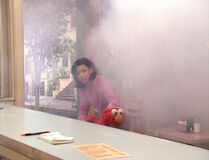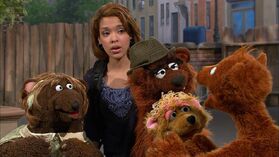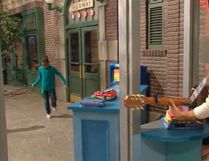No edit summary Tag: sourceedit |
|||
| (19 intermediate revisions by 8 users not shown) | |||
| Line 1: | Line 1: | ||
| + | [[File:Sesame Street panoramic 1970s.jpg|thumb|300px|1970s]] |
||
| − | [[ |
+ | [[File:SesameStreet-StudioSet.jpg|thumb|300px|Photo by [[Mark M. Magner]] (2011)]] |
| − | |||
[[Image:0043sign.jpg|frame|The famous street sign]] |
[[Image:0043sign.jpg|frame|The famous street sign]] |
||
[[Image:Julie_on_ss6.jpg|thumb|300px|Birds' eye view from ''Julie on Sesame Street''.]] |
[[Image:Julie_on_ss6.jpg|thumb|300px|Birds' eye view from ''Julie on Sesame Street''.]] |
||
| Line 20: | Line 20: | ||
The actual studio sets used for Sesame Street have changed over the years, but for most of the recent seasons, the show has been taped at [[Kaufman Astoria Studios]], utilizing stage G. In the feature films ''[[Follow That Bird]]'' and ''[[The Adventures of Elmo in Grouchland]]'', the street was present, though more tangential, but in both cases the usual studio set was abandoned, and a more elaborate version reconstructed. ''Follow That Bird'' was filmed in Toronto, and the new street included an auto mechanic's, bakery, and other buildings, while in ''Adventures of Elmo in Grouchland'', a [[Sesame Street laundromat|laundromat]] was added, a deli, and an assortment of outdoor cafes and vendors, including a snowcone stand. |
The actual studio sets used for Sesame Street have changed over the years, but for most of the recent seasons, the show has been taped at [[Kaufman Astoria Studios]], utilizing stage G. In the feature films ''[[Follow That Bird]]'' and ''[[The Adventures of Elmo in Grouchland]]'', the street was present, though more tangential, but in both cases the usual studio set was abandoned, and a more elaborate version reconstructed. ''Follow That Bird'' was filmed in Toronto, and the new street included an auto mechanic's, bakery, and other buildings, while in ''Adventures of Elmo in Grouchland'', a [[Sesame Street laundromat|laundromat]] was added, a deli, and an assortment of outdoor cafes and vendors, including a snowcone stand. |
||
| − | The street has been around since at least [[1951]], the year [[Hooper's Store]] opened. |
+ | The street has been around since at least [[1951]], the year [[Hooper's Store]] opened. According to an appearance by [[the Count]] on ''[[Late Night with Seth Meyers]]'' in [[2015]], there are currently 85 residents of the street. |
==How to Get to Sesame Street== |
==How to Get to Sesame Street== |
||
| − | Directions to this neighborhood have long been vague, though the question has been asked many times. |
+ | Directions to this neighborhood have long been vague, though the question has been asked many times. One possible means is through the [[Subway Station]]. In [[Christmas Eve on Sesame Street]], the gang can be seen getting off on the 86th St. subway stop, which does exist on the 4, 5 and 6 trains of the Lexington Ave Line. This would place the neighborhood in the Upper East Side. Since Sesame Street is purportedly in New York, and according to the subway signs on the current set, the [[1]], [[2]], [[A]], and [[B]] trains theoretically stop there (though in reality, there is no current station where all four lines connect). |
| ⚫ | |||
| − | One possible means is through the [[Subway Station]]. In [[Christmas Eve on Sesame Street]], the gang can be seen getting off on the 86th St. subway stop, which does exist on the 4, 5 and 6 trains of the Lexington Ave Line. This would place the neighborhood in the Upper East Side. According to the subway signs on the current set, the [[1]], [[2]], [[A]], and [[B]] trains theoretically stop there. (Usage of those four lines suggests a West Side location.) In reality, there is no current station where all four lines connect, although the 1, A, and B trains stop at 59th St.-Columbus Circle, while the 2 train runs express through or past it). |
||
| + | On [[Bob McGrath]]'s 1991 album ''[[Bob's Favorite Street Songs]]'', at the end of his cover of the show's [[Sesame Street Theme|theme song]], a kid's voice urges him to "take the 1-2-3 bus". |
||
| ⚫ | An alternative route was suggested in a [[1972]] episode of ''[[The Electric Company]]''. According to Fargo North, a traveler can go to Vi's Diner (itself vaguely located) and wait for the No. 4 bus, which then goes directly to Sesame |
||
| − | In the 35th anniversary special ''[[The Street We Live On]]'' (also aired as [[Episode 4057]]), [[Elmo]] sends a package to [[Oscar]] addressed with the zip code 10128, an actual New York zip code located in |
+ | In the 35th anniversary special ''[[The Street We Live On]]'' (also aired as [[Episode 4057]]), [[Elmo]] sends a package to [[Oscar]] addressed with the zip code 10128, an actual New York zip code located on the Upper East Side, consistent with the 86th St. subway stop. [[Stinky the Stinkweed]] later received a package in [[episode 4426|a season 44 episode]], with the zip code 11106, used in Queens. |
On November 9, 2009, in honor of the 40th Anniversary, the city of New York named the corner of 64th and Broadway, 123 Sesame Street.<ref>[http://gothamist.com/2009/11/09/sesame_street.php The Gothamist]</ref> |
On November 9, 2009, in honor of the 40th Anniversary, the city of New York named the corner of 64th and Broadway, 123 Sesame Street.<ref>[http://gothamist.com/2009/11/09/sesame_street.php The Gothamist]</ref> |
||
| Line 40: | Line 40: | ||
{{quote|"Can you tell me how to get to Sesame Street?" You get there by going to Time Square, Manhattan, or anywhere you can pick up the local R train. Then hop on the subway and head east to Queens.}} |
{{quote|"Can you tell me how to get to Sesame Street?" You get there by going to Time Square, Manhattan, or anywhere you can pick up the local R train. Then hop on the subway and head east to Queens.}} |
||
| − | |||
| − | |||
| − | |||
| − | If you're looking for where the show was/ is taped, look at [[Teletape Studios]] and [[Kaufman Astoria Studios]], both in New York City. |
||
==Near Losses== |
==Near Losses== |
||
| Line 51: | Line 47: | ||
==Rare Views of the Street== |
==Rare Views of the Street== |
||
| − | <gallery orientation="landscape" |
+ | <gallery orientation="landscape" spacing="small" widths="209" captionalign=center position=center hideaddbutton=true> |
File:2HeaderPhoneBooth.jpg|Across the street from Sesame Street, Luis and the [[Two Headed Monster]] use new telephone booths. |
File:2HeaderPhoneBooth.jpg|Across the street from Sesame Street, Luis and the [[Two Headed Monster]] use new telephone booths. |
||
Image:Acrossstreet-4135.jpg|A rare view of the opposite side of the street as seen from [[Hooper's Store]] in [[Episode 4135]]. |
Image:Acrossstreet-4135.jpg|A rare view of the opposite side of the street as seen from [[Hooper's Store]] in [[Episode 4135]]. |
||
| Line 61: | Line 57: | ||
File:4107.12.jpg|A view looking upwards when Big Bird becomes little in [[Episode 4107]]. |
File:4107.12.jpg|A view looking upwards when Big Bird becomes little in [[Episode 4107]]. |
||
File:ViewFromLaundromat.jpg|A view looking down the street from the Subway, showing a new store added in 2008. |
File:ViewFromLaundromat.jpg|A view looking down the street from the Subway, showing a new store added in 2008. |
||
| − | File:SSFlowerShop.png|The new flower shop which eventually inhabited the vacant store front up the street from the Subway station. |
+ | File:SSFlowerShop.png|[[Flower Shop|The new flower shop]] which eventually inhabited the vacant store front up the street from the Subway station. |
File:Oneworldonesky1.jpg|A view looking upwards in [[One World, One Sky: Big Bird's Adventure]]. Locations projected in 360° (not all shown in this screenshot) include: the [[Sesame Street Library]], the [[Subway Station]] entrance, the [[The Fix-It Shop|Fix It Shop]], [[Hooper's Store]], [[the Arbor]], [[123 Sesame Street]], [[Big Bird's nest]] and a [[The Park|park]]. |
File:Oneworldonesky1.jpg|A view looking upwards in [[One World, One Sky: Big Bird's Adventure]]. Locations projected in 360° (not all shown in this screenshot) include: the [[Sesame Street Library]], the [[Subway Station]] entrance, the [[The Fix-It Shop|Fix It Shop]], [[Hooper's Store]], [[the Arbor]], [[123 Sesame Street]], [[Big Bird's nest]] and a [[The Park|park]]. |
||
| + | 4502-City.png|A CGI city is seen next to the [[Bicycle Shop]] in [[season 45]], showing a playground and the Triboro Bridge among the cityscape. |
||
| + | </gallery> |
||
| + | |||
| + | ===Animated=== |
||
| + | <gallery orientation="landscape" spacing="small" widths="209" hideaddbutton=true position=center captionalign=center> |
||
| + | TSWLO.11.jpg|''[[The Street We Live On]]'' |
||
| + | Street.png|"[[Hot and Cold]]" |
||
</gallery> |
</gallery> |
||
Revision as of 23:20, 28 March 2015
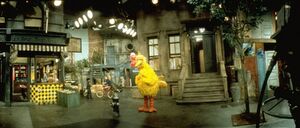
1970s

Photo by Mark M. Magner (2011)
The famous street sign

Birds' eye view from Julie on Sesame Street.
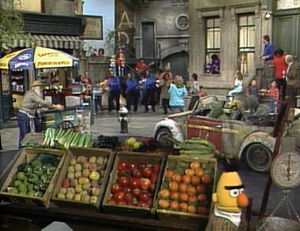
View of Sesame Street as it existed in 1988, from The Sesame Street Special.
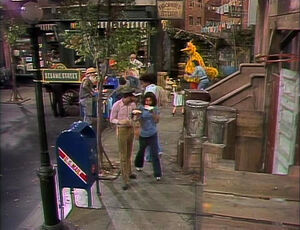
A view of the street at the beginning of episode 0536.

A rare view of the street before it curved at the Arbor, from the first episode.

A map of Sesame Street drawn by Big Bird.

A map of Sesame Street (including Around the Corner) designed by Prairie Dawn.
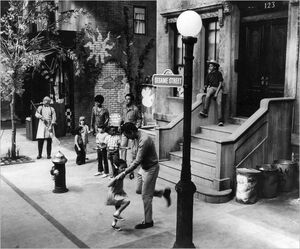
A view of Sesame Street as it existed in 1969, from one of the pilot episodes.

Blueprint of the Sesame Street set, circa. 1970
Sesame Street is the titular street where the central characters live on Sesame Street. Officially located in New York City, as is often confirmed by regional references and the adjacent New York subway, Sesame Street was designed to resemble an urban, inner city landscape, recognizable to children although slightly idealized (though urban grunge was still well accounted for thanks to Oscar the Grouch). While many of the inserts took place in puppet-scale interiors, ranging from Ernie and Bert's apartment and Charlie's Restaurant to the countless walls or the varying game show sets of Guy Smiley, the main storyline scenes have always focused or at least begun on the street and its environs, outside of special location episodes. It serves as a meeting place for human and Muppet cast members alike.
The most central location is 123 Sesame Street, the apartment building whose front stoops are a frequent gathering place for the main characters, and the home to Susan, Gordon, and later, Miles; Maria, Luis, and later, Gabi; and in the basement apartment, Ernie and Bert. The next significant structure is the building which houses Hooper's Store and the Fix-It Shop (and later Mail It Shop and the local laundromat) below, and apartments (including that of Bob and, in the early days, David) above. Between the two is a more open courtyard area, dubbed the Arbor, highlighted by an old carriage house/garage decorated with letters, later turned into a daycare center, and more recently into Gina's veterinary office. The surrounding area includes the fire-escape/stairway area, another popular stoop, and items such as a tire swing for the neighborhood and picnic benches, which are often used by patrons of Hooper's.
To the right of 123 are the somewhat more unusual abodes of Oscar the Grouch and Big Bird. Oscar's trash can is situated upon a pile of crates and often near other debris by the front steps, while a line of salvaged doors demarks the area for Big Bird's nest, consisting of a large literal bird's nest and many other accessories. From the 1970s through the late 1980s, the itinerant fruit cart of Mr. Macintosh and the rolling hotdog stand belonging to Willy frequently dotted the landscape. In later years, the neighborhood expanded Around the Corner, with a host of new sets, which were eventually dropped. Through it all, the street lamppost has been a constant, the green fixture with its familiar "123 Sesame Street" sign often seen at the beginning or end of episodes, and which has essentially become the program's symbol, used on merchandise and, in variations, on most of the international versions of the show.
The actual studio sets used for Sesame Street have changed over the years, but for most of the recent seasons, the show has been taped at Kaufman Astoria Studios, utilizing stage G. In the feature films Follow That Bird and The Adventures of Elmo in Grouchland, the street was present, though more tangential, but in both cases the usual studio set was abandoned, and a more elaborate version reconstructed. Follow That Bird was filmed in Toronto, and the new street included an auto mechanic's, bakery, and other buildings, while in Adventures of Elmo in Grouchland, a laundromat was added, a deli, and an assortment of outdoor cafes and vendors, including a snowcone stand.
The street has been around since at least 1951, the year Hooper's Store opened. According to an appearance by the Count on Late Night with Seth Meyers in 2015, there are currently 85 residents of the street.
How to Get to Sesame Street
Directions to this neighborhood have long been vague, though the question has been asked many times. One possible means is through the Subway Station. In Christmas Eve on Sesame Street, the gang can be seen getting off on the 86th St. subway stop, which does exist on the 4, 5 and 6 trains of the Lexington Ave Line. This would place the neighborhood in the Upper East Side. Since Sesame Street is purportedly in New York, and according to the subway signs on the current set, the 1, 2, A, and B trains theoretically stop there (though in reality, there is no current station where all four lines connect).
An alternative route was suggested in a 1972 episode of The Electric Company. According to Fargo North, a traveler can go to Vi's Diner (itself vaguely located) and wait for the No. 4 bus, which then goes directly to Sesame Street.
On Bob McGrath's 1991 album Bob's Favorite Street Songs, at the end of his cover of the show's theme song, a kid's voice urges him to "take the 1-2-3 bus".
In the 35th anniversary special The Street We Live On (also aired as Episode 4057), Elmo sends a package to Oscar addressed with the zip code 10128, an actual New York zip code located on the Upper East Side, consistent with the 86th St. subway stop. Stinky the Stinkweed later received a package in a season 44 episode, with the zip code 11106, used in Queens.
On November 9, 2009, in honor of the 40th Anniversary, the city of New York named the corner of 64th and Broadway, 123 Sesame Street.[1]
While singing the Sesame Street theme during the Elmopalooza, Telly say he thinks Sesame Street is "that way", pointing to his right, camera left, while on stage. Based on the orientation of the stage within Radio City Music Hall, this would imply that Sesame Street is north of West 50th Street at the Avenue of the Americas. Of course, this is all dependent on Telly's directional sense within the building.
When there was a grease fire at Hooper's Store in 2001, the Engine Company 58/Ladder 26 extinguished it. They serve East Harlem, and the north end of Central Park.
On the Interactive Set Map on Sesamestreet.org, the following text accompanies the landmark star on the lampost:
Near Losses
There have been at least two occasions where Sesame Street almost got torn down. In Save Our Street, Mr. Meanie planned on turning Sesame Street into a parking lot.
In Sesame Street All-Star 25th Birthday: Stars and Street Forever!, millionaire Ronald Grump (a parody of Donald Trump) attempted to evict the residents of Sesame Street, tear the street down and build a building called a Grump Tower. The residents of the street were against this and did whatever they could to stop this from happening. However, Ronald Grump later learned that he couldn't just evict Oscar the Grouch; Oscar had to agree to move. Even after offering to buy him a bigger trash can and more trash Oscar refused to agree to move just to be mean to Ronald Grump and Ronald Grump eventually decided that everybody on the street is too nice to deserve a Grump Tower.
Rare Views of the Street
Animated
Trivia
- Oscar was quoted in Life Magazine about the street, "It used to snow… but it got to be too expensive."[2]
- As of September 2011, there were vacancies in the 123 Sesame Street apartment building.[3]
Sources
- ↑ The Gothamist
- ↑ "The Reflections of Oscar the Grouch", Oscar the Grouch, Guest editor, November 5, 2009. Life Magazine.
- ↑ http://www.youtube.com/watch?v=2kClLgohCrI




